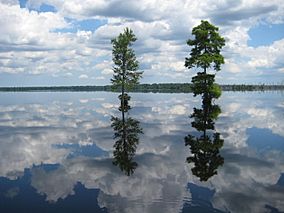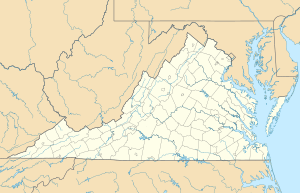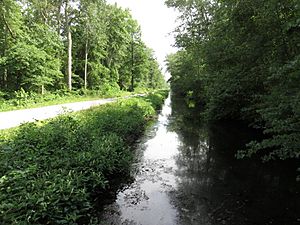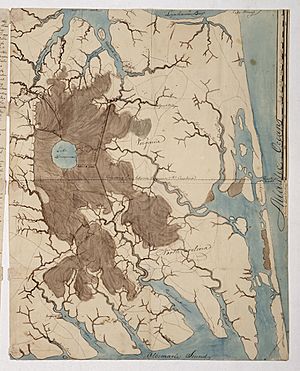Great Dismal Swamp National Wildlife Refuge facts for kids
Quick facts for kids Great Dismal Swamp National Wildlife Refuge |
|
|---|---|
|
IUCN Category IV (Habitat/Species Management Area)
|
|

Photograph of Lake Drummond, Great Dismal Swamp National Wildlife Refuge, Virginia
|
|
| Location | Camden, Gates, Pasquotank counties, North Carolina, Chesapeake, Suffolk, Virginia, United States |
| Area | 112,000 acres (450 km2) |
| Established | 1974 |
| Governing body | U.S. Fish and Wildlife Service |
| Website | Great Dismal Swamp National Wildlife Refuge |
The Great Dismal Swamp National Wildlife Refuge is a special place created in 1974. Its main job is to protect a part of the Great Dismal Swamp. This swamp is a large, wet area found in southeastern Virginia and northeastern North Carolina. It stretches between the cities of Norfolk, Virginia and Elizabeth City, North Carolina.
The refuge is located in parts of Chesapeake and Suffolk in Virginia. It also covers areas in Camden, Gates, and Pasquotank counties in North Carolina.
Contents
What is the Great Dismal Swamp?
The Great Dismal Swamp is a type of southern swamp. It is the northernmost of many swamps along the Atlantic Ocean coast. Other famous swamps include the Everglades in Florida and the Okefenokee in Georgia.
The swamp is very important for its water, native plants, and many different wildlife species. It has a rich history and many interesting stories. The Great Dismal Swamp is one of the last big wild areas left in the Eastern United States.
History of the Swamp
The Great Dismal Swamp is located between the James River in Virginia and the Albemarle Sound in North Carolina. Long ago, the swamp was huge, covering over 1 million acres. However, people have changed the land over time. This has caused about 90% of the original swamp to disappear.
Starting in the 1660s, a group of people known as the Great Dismal Swamp maroons lived freely within the swamp. These were escaped slaves who found safety and built communities in the swamp's higher, drier areas. Other people, including formerly enslaved individuals and some who were still enslaved but lived somewhat independently, also called the swamp home. The swamp was also a stop on the Underground Railroad for those seeking freedom further north.
For centuries, people cut down trees and did other activities that harmed the swamp's natural environment. In 1973, a company called Union Camp Corporation gave 49,100 acres of land to help protect it. The U.S. Congress then officially created the Great Dismal Swamp National Wildlife Refuge in 1974. Today, the refuge has grown to be over 112,000 acres in size.
In 1805, the Dismal Swamp Canal was built. It was used to move timber out of the swamp. Now, the canal is used by recreational boaters. It is part of the Atlantic Intracoastal Waterway.
Plants and Animals of the Swamp
The refuge covers more than 112,000 acres of forested wetlands. Lake Drummond, a natural lake of about 3,100 acres, is found right in the middle of the swamp. Outside the refuge, the state of North Carolina also protects other parts of the swamp.
The Great Dismal Swamp National Wildlife Refuge is special because it sits between two different natural regions. This means it has a wide variety of plants and animals. Common trees include Bald cypress, black gum, maple, Atlantic white cedar, and pine.
Many animals live here, such as black bears, bobcats, otters, and weasels. There are also over 70 types of reptiles and amphibians. More than 200 bird species can be seen in the swamp throughout the year. About 96 of these bird species even build their nests there. Many migratory songbirds, like warblers, visit the swamp from late April to mid-May.
Fun Things to Do
The refuge is open every day during daylight hours. There is no fee to enter. The refuge headquarters is open on weekdays, except for national holidays.
There are many fun activities you can do at the refuge:
- Birdwatching: Look for the many different bird species.
- Photography: Capture the beauty of the swamp and its wildlife.
- Hiking and Bicycling: Explore the trails and unpaved roads.
- Boating and Canoeing: You can launch a boat into the Feeder Ditch to reach Lake Drummond.
- Fishing: Enjoy fishing in the lake and canals.
- Deer Hunting: This is allowed in certain areas during specific seasons.
You can even camp at a special campsite maintained by the Army Corps of Engineers. It is located on the feeder ditch canal near Lake Drummond.
Lake Drummond is a popular spot today for fishermen, sightseers, and boaters. You can also take boat tours from the Dismal Swamp Canal to Lake Drummond.
For hiking, check out the Dismal Town Boardwalk Trail. It is about 0.75 miles long and is even wheelchair-accessible. It winds through part of the swamp. Many of the refuge's unpaved roads are also great for bicycling. The Dismal Swamp Canal Trail is another option. It is an 8.5-mile trail that follows the eastern side of the swamp.





